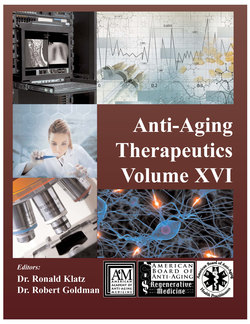Читать книгу Anti-Aging Therapeutics Volume XVI - A4M American Academy - Страница 6
На сайте Литреса книга снята с продажи.
The Anti-Aging Medical Model
ОглавлениеThe goal of anti-aging medicine is not to merely prolong the total years of an individual's life, but to ensure that those years are enjoyed in a productive and vital fashion. The clinical specialty of anti-aging medicine utilizes diagnostic protocols that are supported by scientific evidence to arrive at an objective assessment upon which effective treatment is assigned. Physicians who dispense anti-aging medical care are concerned with the restoration of optimal functioning of the human body’s systems, organs, tissues, and cells.
People may lose 30 minutes of life expectancy for every two cigarettes they smoke, for being 11 pounds overweight, and for eating an extra portion of red meat daily. David Spiegelhalter6, from the University of Cambridge, has coined the concept of a “microlife," defined as 30 minutes of life expectancy – as a practical substitution for the statistical concept of the hazard ratio. He computed that a million half hours -- or 57 years -- roughly corresponds to a lifetime of adult exposure to any given hazard. Further, he noted that at current mortality rates in the UK, a 35-year-old can expect to live another 55 years or 481,000 hours or very nearly a million microlives. Spiegelhalter has calculated that people may lose 30 minutes of life expectancy for every two cigarettes they smoke, for being 11 pounds overweight, and for eating an extra portion of red meat daily. Dr Spiegelhalter submits that this approach "allows a general, non-academic audience to make rough but fair comparisons between the sizes of chronic risks, and is based on a metaphor of 'speed of ageing.'
Potentially 37 million premature deaths over 15 years may be prevented, simply if people modulated six specific modifiable risk factors. Various countries aim to reduce premature mortality from four main non-communicable diseases (NCDs)-namely – cardiovascular diseases, chronic respiratory diseases, cancers, and diabetes. These nations have targeted to reduce these disease incidences by 25% from 2010 levels by 2025. Potentially 37 million premature deaths over 15 years may be prevented, simply if nations adopt the anti-aging medical model. Majid Ezzati7 from Imperial College London (United Kingdom), and colleagues report that this target may be achievable by the reduction of six specific modifiable risk factors. Using country-level data on deaths and risk factors and epidemiological models, the researchers estimate the number of deaths that could be prevented between 2010 and 2025 by reducing the burden of each of the six risk factors to globally-agreed target levels -- tobacco use (30% reduction and a more ambitious 50% reduction), alcohol use (10% reduction), salt intake (30% reduction), high blood pressure (25% reduction), and halting the rise in the prevalence of obesity and diabetes. Overall, the findings suggest that meeting the targets for all six risk factors would reduce the risk of dying prematurely from the four main NCDs by 22% in men and 19% for women in 2025 compared to what they were in 2010. Worldwide, this improvement is equivalent to delaying or preventing at least 16 million deaths in people aged 30-70 years and 21 million in those aged 70 years or older over 15 years. The authors predict that the largest benefits will come from reducing high blood pressure and tobacco use. They calculate that a more ambitious 50% reduction in prevalence of smoking by 2025, rather than the current target of 30%, would reduce the risk of dying prematurely by more than 24% in men and by 20% in women. The study investigators submit that: “If the agreed risk factor targets are met, premature mortality from the four main NCDs will decrease to levels that are close to the 25×25 target, with most of these benefits seen in low-income and middle-income countries.”
A steady rise in life expectancy over the past two decades is accompanied by prolonged health in later life. David Cutler8, from Harvard University (Massachusetts, USA), and colleagues analyzed data collected between 1991 and 2009 from nearly 90,000 individuals who responded to the Medicare Current Beneficiary Survey (MCBS), allowing researchers to link survey responses to participants' Medicare records for the rest of their life – effectively enabling a determination as to exactly how far participants were from death when they answered the survey. "With the exception of the year or two just before death, people are healthier than they used to be," observes the lead investigator, elaborating that: "Effectively, the period of time in which we're in poor health is being compressed until just before the end of life. So where we used to see people who are very, very sick for the final six or seven years of their life, that's now far less common. People are living to older ages and we are adding healthy years, not debilitated ones. …People are much better educated about their health now."
